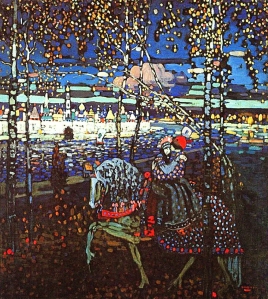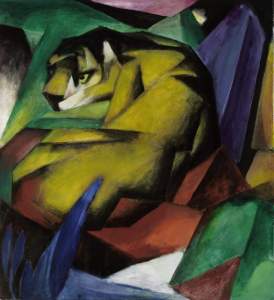“What comes to mind when you picture expressionism?” asks the wall text in the first room of the Expressionists exhibition at Tate Modern. Until 20th October 2024, the gallery is exploring the works of several artists associated with the expressionist movement, particularly those belonging to a circle of painters known as the Blue Rider (Der Blaue Reiter).
The Blue Rider was a group of modern expressionist artists formed in Munich, Germany, in 1911. Led by artists like Wassily Kandinsky (1866-1944), Gabriele Münter (1877-1962), and Franz Marc (1880-1916), the group focused on exploring the emotional and spiritual aspects of art through abstract and symbolic expression. The collective aimed to liberate art from traditional constraints and advocated for creative expression.
The Blue Rider movement, which began with the formation of the NKVM (New Artists’ Association of Munich) in 1909, was ahead of its time in welcoming women artists such as Marianne Werefkin (1860-1938) and Elisabeth Epstein (1879-1956). It successfully advanced the careers of many artists, who participated in national and international exhibitions. The Blue Rider artists expressed interest in local crafts, religious artefacts of Bavarian craftspeople, toys, popular prints from Eastern and Central Europe, and prints and reverse glass paintings from South and East Asia.
Friendship was a strong bond within this diverse, close-knit community of artists. They frequently met in Murnau, a rural town in Bavaria, during summers to relax, work, and create art, drawing inspiration from the outdoor spaces. They experimented with art and supported each other, posing as models and creating new works, such as Gabriele Münter’s Jawlensky and Werefkin (1909). Münter expressed that they were simply a group of friends who shared a passion for painting and supported each other’s well-being and happiness.
While in Murnau, artists posed for each other, as seen in Münter’s Portrait of Marianne Werefkin (1909). Münter described Werefkin as a “woman of grand appearance, self-confident, commanding, extravagantly dressed, with a hat as big as a wagon wheel, on which there was room for all sorts of things.” Besides painting, Münter became involved with local arts and crafts, including reverse glass painting, which consisted of painting pictures on the back of a clear glass panel. Münter and the other artists admired the bold effect of the colours when viewed from the other side.
The Blue Rider artists believed in the power of colour and composition. One painter, Franz Marc used colour theory in his art, associating blue with masculinity, yellow with femininity, and red with the intensity of the world. He was known to view “rings of colours” through prisms as he applied layers of different shades to his canvases. Tate Modern invites visitors to view one artwork through a prism to understand what Marc looked for in his paintings.
Kandinsky, in particular, found importance in the relationship between music and colour. He claimed he could “hear” his paintings, with colours and shapes having unique sounds and tones. After attending a concert by composer Arnold Schoenberg (1874-1951), Kandinsky created Impression III (Concert) (1911), featuring a black angular piano floating on a wave of yellow sound.
Kandinsky’s later works became abstract, but his earlier paintings were more conventional. The Blue Rider got its name from a painting by Kandinsky, who also painted another artwork involving a horse, Riding Couple (1906-7). The horse and rider symbolise the ability to move to another “world” and Kandinsky regarded blue as the most spiritual colour.
As a 22-year-old law student, Kandinsky took part in a field trip to the north-eastern Vologda province of the Russian Empire. His experience with the art, culture and traditions of the local Finno-Ugric Komi people encouraged him to seek a new direction in life. Many of his early works reflect the types of buildings and clothing he encountered on these travels.
Artists found a safe space in the theatre to explore sexuality and gender roles freely, challenging societal norms. The Blue Rider group was ahead of its time in allowing women into its circle but also accepted people of all sexualities. Marianne Werefkin, a Russian-born painter, dedicated much of her time to supporting the arts. Rejecting gender labels, she famously said, “I am not a man, I am not a woman, I am I.”
Werefkin painted dancer and choreographer Alexander Sacharoff (1886-1963), who embraced fluid and androgynous identities on and off the stage. He became known for wearing extravagant costumes, such as hats adorned with flowers and wax fruit. Werefkin’s portrait of the performer challenged societal norms and expectations by depicting Sacharoff in his female garb.
Werefkin preferred to use intense, colourful tempera paints rather than oils used by realist painters. She frequently conveyed the time of day in her artworks by using contrasting light and dark colours. The Skaters (1911), for example, depicts shadowy figures skating under the moonlight. She achieved this effect by limiting her colour palette to shades of blue.
One group member, Franz Marc, believed animals represented a spiritual world in his paintings. Even before joining the Blue Rider, Marc was interested in philosophy and spirituality. Although Marc had a background in Christian theology, he felt called to Buddhism, which in turn inspired his engagement with animism, the belief in the spirituality of animals and the natural world. Many of his works involved geometric shapes, as seen in Tiger (1912). Tigers are important in Buddhist and Japanese traditions, and the selection of colours and shapes aimed to evoke wild animal energy.
Several in the group were interested in children’s art, for instance, Marc’s wife Maria Franck-Marc (1876-1955). Her paintings featured children playing and using their imagination, such as in Girl with Toddler (c. 1913), in which a young girl lovingly cradles a rosy-cheeked toddler.
Another member, Gabriele Münter, played a crucial role in creating opportunities for women artists. She was primarily a painter but also a skilled photographer. She often used a camera to take photographs before making sketches on paper. As an avid traveller, she took hundreds of photos during her journeys across Europe, the USA, and Africa in the 1900s. She was especially interested in classic Tunisian architecture, particularly its geometric shapes.
Lyonel Feininger (1871-1956) used geometric shapes in his landscapes and building paintings. Behind the Church (1916), which depicts the square outside the City Church in Weimar, Feininger overlapped cubes and triangles of gradated colour to build up the scene. The result is a strange beauty of what, in reality, was a vast open space.
The exhibition introduces several artists involved in the Blue Rider circle, some in more detail than others. Albert Bloch (1882-1961), for instance, was the only American associated with the group, although he lived in Germany in the 1910s. Alexej von Jawlensky (1864-1941) joined the Blue Rider while living in Germany. After the First World War, he became one of the Blue Four, along with Kandinsky, Feininger and Paul Klee (1879-1940).
The Blue Rider group disbanded at the outbreak of World War One. With the rise of Nazism, their works were regarded as degenerate, and several artists fled from Europe. Yet, following the Second World War, many of their surviving artworks appeared in exhibitions in Germany, signalling the relevance of their collective artistic vision. Post-war artistic communities admired the Blue Rider artists, and their work continued influencing artists over many generations. They continue to inspire people today, as evidenced in the exhibition with optional QR codes to scan to see contemporary artists’ responses to certain paintings and ideas.
Tate Modern provides visitors with more than paintings on walls. The curators allow individuals to experience Kandinsky’s love of music and Franz Marc’s use of colour wheels and prisms. They even make people look at art in a different light – literally.
Tickets are available to book for the Expressionists exhibition until 20th October 2024. Entry is £22 for adults.
If you would like to support my blog, become a Patreon from £5p/m or “buy me a coffee” for £3. Thank You!













Your excellent blog introduces me to another group of colourful artists most of whom I have not heard of before. You illustrate your writing with a good choice of artwork and bring to life the essence of their genre.
Thank-you Hazel for another fine piece of writing.
Another gem by the irrepressible Hazel. It’s good to read about a group of friends who looked out and after each other while pushing the boundaries of art and who was allowed to paint. The blue Rider group in allowing women to equally be artistic without the constraints of the society norms is inspirational.
Thank you Hazel for sharing your considerable knowledge and skill.
Another very comprehensive account of the work of this group of artists, not many of whom I had any knowledge. I now feel much better acquainted with them so thank you once again Hazel.